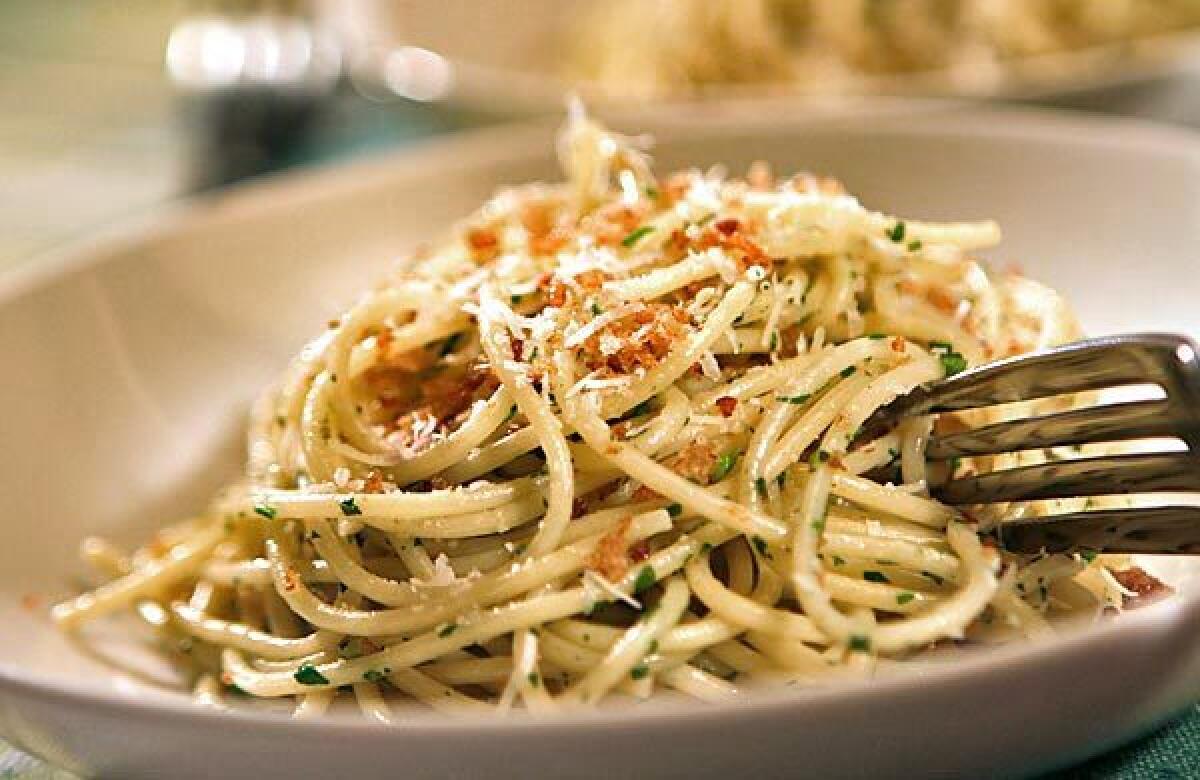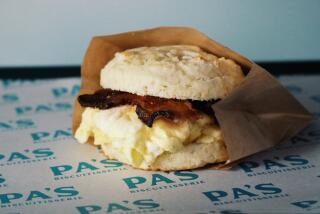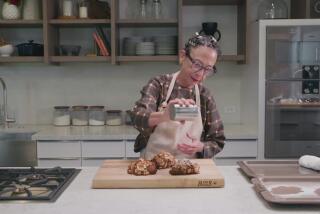The California Cook: Mighty, mighty bread crumbs

- Share via
I’ve just discovered the magic of fresh bread crumbs. You might say it’s about time, after 30 years of cooking. But I would remind you that I said the “magic” of fresh bread crumbs, not the “utility.”
Everyone knows about using bread crumbs for coating a schnitzel or any other fried, baked or broiled thing. Or stuffing a bird or whole fish. Or scattering across the top of a gratin or tian before browning. I’ve even used them as toppings for fruit desserts, like a less-sweet version of a crisp.
But what I’d never really realized was the true potential of bread crumbs, how instead of being bland character actors toiling in the background, they can actually become the stars of a dish, or at least a very impressive second lead.
Top steamed or braised vegetables with some carefully toasted bread crumbs and the dish is transformed by the infusion of crunch and that golden brown flavor.
Scatter them in a salad and they work like micro-croutons (I’m almost positive I actually was served these once; just imagine some poor kitchen slave having to painstakingly shave a close-crumbed pain-de-mie into perfect micron-sized cubes).
Think you’ve got a winning burger recipe? Submit it to the L.A. Times’ first Battle of the Burgers.
One of my favorite recent bread crumb dishes was also the simplest: Toast bread crumbs, boil spaghetti, chop arugula. Mix well. Utterly delicious.
Ironically, it was probably a character actor who first got me thinking about a starring role for bread crumbs in the first place — and I have to admit I wasn’t that impressed. My much-missed friend, the late Vincent Schiavelli, was a big advocate for them (if you don’t remember the name, you remember the face from “Taxi,” “Ghost” and “One Flew Over the Cuckoo’s Nest,” among many others.)
Schiavelli was very proud of his Sicilian heritage. His grandfather, Andrea, had been one of the last of the monzus — the French-trained chefs for the Sicilian aristocracy — and Vincent was a great cook as well.
And he was a liberal user of bread crumbs, muddica in Sicilian dialect. “It’s because we’re greedy,” he would laugh. “We want to feel like we get a mouthful with every bite.”
But to tell you the truth, as good a cook as Schiavelli was, I was never a big fan of the way he used bread crumbs. He chose dry rather than fresh, and they were ground very fine. Even after toasting, the texture was somewhat sandy (and, yes, mouth-filling) rather than crunchy and light.
The next two steps on my journey toward bread crumb understanding came very close together, which is probably why they made such an impression.
First came a couple of meals testing and perfecting Judy Rodgers’ bread crumb-fried eggs from “The Zuni Cafe Cookbook” for a previous column. Even though I’d prepared this dish dozens of times before, I couldn’t get over how the crunch transformed a familiar dish. And when I served it over steamed asparagus, wheels started turning.
That same week I had dinner at Steve Samson and Zach Pollack’s new restaurant, Sotto, where they used toasted bread crumbs to garnish a salad of grilled romaine.
That’s when the bells finally rang. Why couldn’t I use these crunchy toasted fresh bread crumbs the same way Vincent had used the dried?
“I’m going to steal this,” I remember saying to one of my companions.
My first experiment was with steamed asparagus. I’d gotten nice thick stalks and steamed them to that exquisite mousse-like texture and dressed them with olive oil and lemon. So far, same as usual. But this time I toasted some fresh bread crumbs in olive oil and scattered them over the top.
Just that simple addition — just that little bit of crunch to contrast with the tender spears — made what is always one of my favorite dishes even better. I then went on a spree, tossing bread crumbs onto almost everything but my morning oatmeal (though, come to think of it …).
Bread crumbs are so easy to make. The most important thing is starting with fresh bread. Neither dried crumbs nor panko worked as well in these kinds of dishes — the dried crumbs were just as I remembered Vincent’s, and the panko had a stale taste.
Anyway, all you have to do to make fresh bread crumbs is take some fresh bread, slice away the crusts, cut the interior into a rough dice and then grind it in the food processor. A 1-pound loaf will usually make 3 to 4 cups of bread crumbs. Any crumbs you don’t use can be tightly sealed in a plastic bag and frozen for later.
You want an honest loaf, but you don’t want one with overly assertive flavors. Leave that strong sourdough for something else. Some cooks recommend “stale” bread, and that’s fine if by stale you mean a day or two old. Stale in my house usually means that baguette that has been sitting on the counter since the weekend. That bread is rock-hard, and chopping it in the food processor is like grinding stones.
Don’t chop the bread too fine and don’t worry about making the crumbs uniform. They can vary in size from small gravel to wet sand. In fact, that kind of variation is part of the charm — you get different degrees of crunch.
Put the bread crumbs and a pinch of salt in a small saucepan with just enough oil to moisten them — 3/4 cup of bread crumbs will take 11/2 to 2 tablespoons of oil. You don’t want to use too much or the crumbs will be greasy.
Toast the bread crumbs over medium-high heat, stirring almost constantly. At first, you’ll just be mixing the oil and the bread crumbs. Then you’ll notice that the crumbs begin to firm and crisp and darken slightly. They’re still not ready. Keep going until they definitely change color. (What color? Toast!)
They should be a solid medium brown, with even some flecks of dark. Taste a small spoonful to be sure they’re crunchy. Careful, those guys are hot.
Immediately remove the bread crumbs from the heat, give another couple of stirs and then transfer them to a bowl to cool. If you leave them in the hot pan, they’ll scorch.
Plain bread crumbs are great, but you can also flavor them. Two of my favorites are garlic and lemon (now that I’ve mentioned it, I’ve got to try combining them).
To make garlic bread crumbs, just split a whole peeled clove in half and toast it along with the bread (doing this gives you the round sweet taste of the garlic without the harshness). To make lemon-flavored crumbs, simply add finely shredded lemon zest while you’re toasting.
I used the lemon bread crumbs to top a Swiss chard dish I’d been working on all winter (plant chard in the fall, you’ll be looking for ways to use it well into the spring). Essentially, it’s just a kind of Sicilian-style braise of the stems and shredded leaves, with garlic, lemon and golden raisins added for flavor. For some reason, it had just never come together the way I wanted it to; the flavors were unfocused and the colors were unappealing. A couple of spoonfuls of golden brown, lemon-flavored bread crumbs over top and I had a dish I’ll go back to forever (well, at least as long as the chard holds out, which is beginning to seem that long).
The garlic bread crumbs went into that spaghetti with chopped fresh arugula. This is one of those combinations that sounds so simple but is so delicious. I’ve made it four times in the last three weeks. Just a handful of ingredients and yet all of that flavor. It’s kind of a crumby miracle.
More to Read
Eat your way across L.A.
Get our weekly Tasting Notes newsletter for reviews, news and more.
You may occasionally receive promotional content from the Los Angeles Times.











